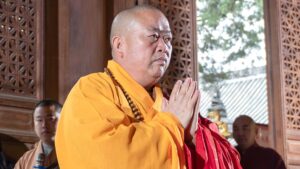https://theworldfinancialforum.com/participate/

Shi Yongxin, the abbot of the world-renowned Shaolin Temple, is being investigated by multiple agencies for embezzlement, “improper relationships with multiple women” and “fathering illegitimate children”, the temple said on Sunday.
The 1,500-year-old Shaolin Temple, located in a mountain range in central China’s Henan province, attracts thousands of disciples every year – some from across the world.
Mr Shi, who has been Shaolin Temple’s abbot since 1999, has earned the nickname “CEO monk” for transforming the institution into a global brand.
He has been stripped of his ordination certificate amid the probe, China’s Buddhist association said on Monday.
The ordination certificate is proof of someone’s acceptance into the monastic community.
“Shi Yongxin’s actions are extremely bad, seriously damaging the reputation of the Buddhist community and the image of monks,” the Buddhist Association of China said in its statement.
Under his leadership, the temple started opening schools outside China and formed a travelling troupe of monks who performed Shaolin kung fu shows – the temple’s signature style of martial arts.
News of Mr Shi being investigated was the most read topic on Weibo on Monday morning. The last post on his own Weibo account, which has more than 880,000 followers and had been updated daily with Buddhist teachings, is dated 24 July.
Mr Shi also came under scrutiny in 2015 for allegedly having sexual relations with women and embezzling temple funds. He also allegedly received expensive gifts from companies and local governments, including a Volkswagen SUV and a robe with gold thread.
He was investigated at the time for embezzlement and fathering several children, but was later cleared of the charges.

In an interview with BBC Chinese in 2015, Mr Shi was asked about the allegations of corruption and affairs with women.
“If there were a problem, it would have surfaced long ago,” he said at the time.
Shaolin Temple also came under fire in 2015 over a plan to build a nearly $300m temple complex which also included a hotel, a kung fu school and a golf course.
The name “Shaolin” has gained prominence in pop culture over the years, including being the title of a 1982 film starring Jet Li. The temple is referenced in songs by American hip-hop group Wu-Tang Clan and inspired a spinoff of the video game Mortal Kombat.
In late July 2025, the venerated Shaolin Temple—synonymous with Zen Buddhism and martial arts—was thrown into turmoil as its long-time abbot, Shi Yongxin, was publicly placed under a criminal investigation. The shocking headlines exposed a tangled saga of alleged financial improprieties and ethical violations that have irreversibly fractured his reputation.
Allegations Unveiled
On July 27, the Shaolin Temple announced that Shi Yongxin stood accused of serious criminal offenses. He is suspected of embezzling project funds and misappropriating temple assets—an astonishing charge given his decades-long stewardship of one of Buddhism’s most iconic institutions Financial TimesReutersAP News.
Equally sensational were allegations of moral misconduct: the abbot is accused of maintaining improper relationships with multiple women over an extended period and fathering at least one illegitimate child—an egregious breach of Buddhist celibacy vows Financial TimesThe Daily BeastReutersThe Washington Post.
Monastic Credentials Revoked
In an unusually forceful response, the Buddhist Association of China withdrew Shi’s ordination certificate, a rare and severe rebuke that labeled his actions as having “seriously damaged the reputation of the Buddhist community and the image of monks” Financial TimesThe Daily BeastChina DailyGlobal Times.
A Legacy Tarnished
Shi Yongxin, originally Liu Yingcheng, became abbot of Shaolin Temple in 1999. But it was his commercial vision that earned him the moniker “CEO monk”—under his leadership, Shaolin transformed into a global brand complete with kung fu troupes, international cultural centers, merchandise, publications, and more Financial TimesReutersWikipediaCNA.
While many praised his entrepreneurial spirit and push to modernize and internationalize one of China’s spiritual treasures, critics long argued his business ventures had diluted its sacred mission and turned it into a money-making enterprise—with extravagant gifts, flashy vehicles, and lavish robes fueling the fire of public skepticism Financial TimesWikipediaCNA.
Notably, in 2015, Shi faced similar allegations of misconduct—claims that were decisively dismissed after a provincial investigation concluded there was no evidence of wrongdoing Financial TimesAP NewsWikipedia.
A Crisis of Faith and Governance
The renewed scandal has ignited broader debate within China over the integrity of religious institutions, particularly those that have embraced commercial ventures. In the wake of the controversy, the Buddhist Association and state regulators have pledged stricter oversight of religious bodies, signaling possible reforms in how temples operate and are held accountable South China Morning PostCNA.
Already, signs of change are apparent at Shaolin: references to Shi have been removed or obscured within the temple complex, commercial banners and practices appear toned down, and visitor numbers have reportedly dipped CNA.
What Comes Next?
Legal consequences: The ongoing multi-agency investigation may lead to criminal charges or penalties, depending on the evidence uncovered.
Institutional self‑reflection: Leadership at Shaolin and within China’s Buddhist establishment may face pressure to recalibrate the balance between spiritual purpose and commercial enterprise.
Reform momentum: This scandal could catalyze regulatory changes—perhaps mandating financial transparency, limiting commercial interests, or redefining the role of Buddhist leaders in public life.
Final Thoughts
Shi Yongxin’s dramatic fall from the epithet of “CEO monk” to that of a defrocked abbot under investigation is emblematic of a deeper tension in modern Chinese Buddhism: how to preserve spiritual integrity while adapting to commercial and cultural currents. As the Shaolin Temple embarks on a new chapter, its trials may indeed herald broader shifts in how religion, tradition, and commerce coexist in an evolving China.